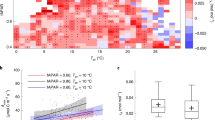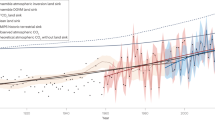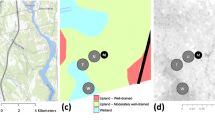Abstract
Limited understanding of carbon dioxide sinks and sources on land is often linked to the inability to distinguish between the carbon dioxide taken up by photosynthesis, and that released by respiration1,2. Carbonyl sulphide, a sulphur-containing analogue of carbon dioxide, is also taken up by plants, and could potentially serve as a powerful proxy for photosynthetic carbon dioxide uptake, which cannot be directly measured above the leaf scale. Indeed, variations in atmospheric concentrations of carbonyl sulphide are closely related to those of carbon dioxide at regional, local and leaf scales3,4,5,6,7,8,9. Here, we use eddy covariance and laser spectroscopy10 to estimate the net exchange of carbon dioxide and carbonyl sulphide across three pine forests, a cotton field and a wheat field in Israel. We estimate gross primary productivity—a measure of ecosystem photosynthesis—directly from the carbonyl sulphide fluxes, and indirectly from carbon dioxide fluxes. The two estimates agree within an error of ±15%. The ratio of carbonyl sulphide to carbon dioxide flux at the ecosystem scale was consistent with the variability in mixing ratios observed on seasonal timescales in the background atmosphere. We suggest that atmospheric measurements of carbonyl sulphide flux could provide an independent constraint on estimates of gross primary productivity, key to projecting the response of the land biosphere to climate change.
This is a preview of subscription content, access via your institution
Access options
Subscribe to this journal
Receive 12 print issues and online access
$259.00 per year
only $21.58 per issue
Buy this article
- Purchase on Springer Link
- Instant access to full article PDF
Prices may be subject to local taxes which are calculated during checkout



Similar content being viewed by others
References
Raupach, M. R. Pinning down the land carbon sink. Nature Clim. Change 1, 148–149 (2011).
Pan, Y. et al. A large and persistent carbon sink in the World’s forests. Science 333, 988–993 (2011).
Campbell, J. E. et al. Photosynthetic control of atmospheric carbonyl sulfide during the growing season. Science 322, 1085–1088 (2008).
Montzka, S. A. et al. On the global distribution, seasonality, and budget of atmospheric carbonyl sulfide (COS) and some similarities to CO2 . J. Geophys. Res. 112, 9302–9317 (2007).
Blonquist, J. M. et al. The potential of carbonyl sulfide as a proxy for gross primary production at flux tower sites. J. Geophys. Res. 116, 4019–4037 (2011).
Stimler, K., Montzka, S., Berry, J. A, Rudich, Y. & Yakir, D. Relationships between carbonyl sulfide (COS) and CO2 during leaf gas exchange. New Phytol. 186, 869–978 (2010).
Stimler, K., Berry, J. A. & Yakir, D. Variations in leaf COS/CO2 uptake across species and a possible COS mediated H2S effect on stomatal conductance. Plant Physiol. 158, 524–530 (2011).
Sandoval-Soto, L. et al. Global uptake of carbonyl sulfide (COS) by terrestrial vegetation: Estimates corrected by deposition velocities normalized to the uptake of carbon dioxide (CO2). Biogeosciences 2, 125–132 (2005).
Seibt, U., Kesselmeier, J., Sandoval-Soto, L., Kuhn, U. & Berry, J. A. A kinetic analysis of leaf uptake of COS and its relation to transpiration, photosynthesis and carbon isotope fractionation. Biogeosciences 7, 333–341 (2010).
Stimler, K., Nelson, D. & Yakir, D. High precision measurements of atmospheric concentrations and plant exchange rates of carbonyl sulfide (COS) using mid-IR quantum cascade laser. Glob. Change Biol. 16, 2496–2503 (2010).
Bruhl, C., Lelieveld, J., Crutzen, P. J. & Tost, H. The role of carbonyl sulphide as a source of stratospheric aerosol and its impact on climate. Atmos. Chem. Phys. 12, 1239–1253 (2012).
Watts, S. F. The mass budgets of carbonyl sulfide, dimethyl sulfide, carbon disulfide and hydrogen sulfide. Atmos. Environ. 34, 761–779 (2000).
Kettle, A. J. et al. Comparing forward and inverse models to estimate the seasonal variation of hemisphere-integrated fluxes of carbonyl sulfide. Atmos. Chem. Phys. 2, 343–361 (2002).
Protoschill-Krebs, G. & Kesselmeier, J. Enzymatic pathways for the metabolization of carbonyl sulphide (COS) by higher plants. Bot. Acta 108, 445–448 (1992).
Baldocchi, D. et al. FLUXNET: A new tool to study the temporal and spatial variability of ecosystem-scale carbon dioxide, water vapor, and energy flux densities. Bull. Am. Meteorol. Soc. 82, 2415–2434 (2001).
Kesselmeier, J., Teusch, N. & Kuhn, U. Controlling variables for the uptake of atmospheric carbonyl sulfide (COS) by soil. J. Geophys. Res. 104, 11577–11584 (1999).
Steinbacher, M., Bingemer, H. G. & Schmidt, U. Measurements of the exchange of carbonyl sulfide (OCS) and carbon disulfide (CS2) between soil and atmosphere in a spruce forest in central Germany. Atmos. Environ. 38, 6043–6052 (2004).
Kuhn, U. et al. Carbonyl sulfide exchange on an ecosystem scale: Soil represents a dominant sink for atmospheric COS. Atmos. Environ. 33, 995–1008 (1999).
Yi, Z. et al. Soil uptake of carbonyl sulfide in subtropical forests withdifferent successional stages in south China. J. Geophys. Res. 112, 8302–8313 (2007).
Sandoval-Soto, L., Kesselmeier, M., Schmitt, V., Wild, A. & Kesselmeier, J. Observations of the uptake of carbonyl sulfide (COS) by trees under elevated atmospheric carbon dioxide concentrations. Biogeosciences 9, 2935–2945 (2012).
Reichstein, M. et al. On the separation of net ecosystem exchange into assimilation and ecosystem respiration: Review and improved algorithm. Glob. Change Biol. 11, 1424–1439 (2005).
Seibt, U., Rajabi, A., Griffiths, H. & Berry, J. A. Carbon isotopes and water use efficiency: Sense and sensitivity. Oecologia 155, 441–454 (2008).
Wohlfahrt, G. et al. Carbonyl sulfide (COS) as a tracer for canopy photosynthesis, transpiration and stomatal conductance: Potential and limitations. Plant Cell Envir. 35, 657–667 (2012).
Wilske, B. et al. The CO2 exchange of biological soil crusts in a semiarid grass-shrubland at the northern transition zone of the Negev desert, Israel. Biogeosciences 5, 1411–1423 (2008).
Kuhn, U. & Kesselmeier, J. Environmental variables controlling the uptake of carbonyl sulfide by lichens. J. Geophys. Res. 105, 26783–26792 (2000).
Falge, E. et al. Seasonality of ecosystem respiration and gross primary production as derived from FLUXNET measurements. Agri. Forest Meteorol. 113, 53–74 (2002).
Grunzweig, G. M., Lin, T., Rotenberg, E., Schwartz, A. & Yakir, D. Carbon sequestration in arid-land forest. Glob. Change Biol. 9, 791–799 (2003).
Goulden, M. L., Munger, J. W., Fan, S. M., Daube, B. C. & Wofsy, S. C. Measurements of carbon sequestration by long-term eddy covariance: Methods and a critical evaluation of accuracy. Glob. Change Biol. 2, 169–182 (1996).
Acknowledgements
We are grateful to G. Fratini for help using EddyPro, and to M. Cuntz, G. Wohlfart and J. Berry for helpful discussions. The technical help of H. Sagi and A. Pelner are gratefully acknowledge. This work was made possible by financial support from the Israel Science Foundation (ISF), the Minerva foundation, the JNF-KKL, and the C. Wills and R. Lewis program in Environmental Science.
Author information
Authors and Affiliations
Contributions
D.Y. conceived the study. D.A. performed all COS measurements. D.A., E.R., U.D. and F.T. carried out all of the field measurements and data analysis. S.A.M. provided the atmospheric data. D.Y. and D.A. wrote the paper with discussions and contributions to interpretations of the results from all co-authors.
Corresponding author
Ethics declarations
Competing interests
The authors declare no competing financial interests.
Supplementary information
Supplementary Information
Supplementary Information (PDF 1128 kb)
Rights and permissions
About this article
Cite this article
Asaf, D., Rotenberg, E., Tatarinov, F. et al. Ecosystem photosynthesis inferred from measurements of carbonyl sulphide flux. Nature Geosci 6, 186–190 (2013). https://doi.org/10.1038/ngeo1730
Received:
Accepted:
Published:
Issue Date:
DOI: https://doi.org/10.1038/ngeo1730
This article is cited by
-
Evidence and attribution of the enhanced land carbon sink
Nature Reviews Earth & Environment (2023)
-
Large variations in afforestation-related climate cooling and warming effects across short distances
Communications Earth & Environment (2023)
-
Sea animal colonies enhance carbonyl sulfide emissions from coastal Antarctic tundra
Communications Earth & Environment (2023)
-
Root and rhizosphere contribution to the net soil COS exchange
Plant and Soil (2023)
-
Carbonyl sulfide (COS) and carbon disulfide (CS2) exchange fluxes between cotton fields and the atmosphere in the arid area in Xinjiang, China
Environmental Geochemistry and Health (2019)



